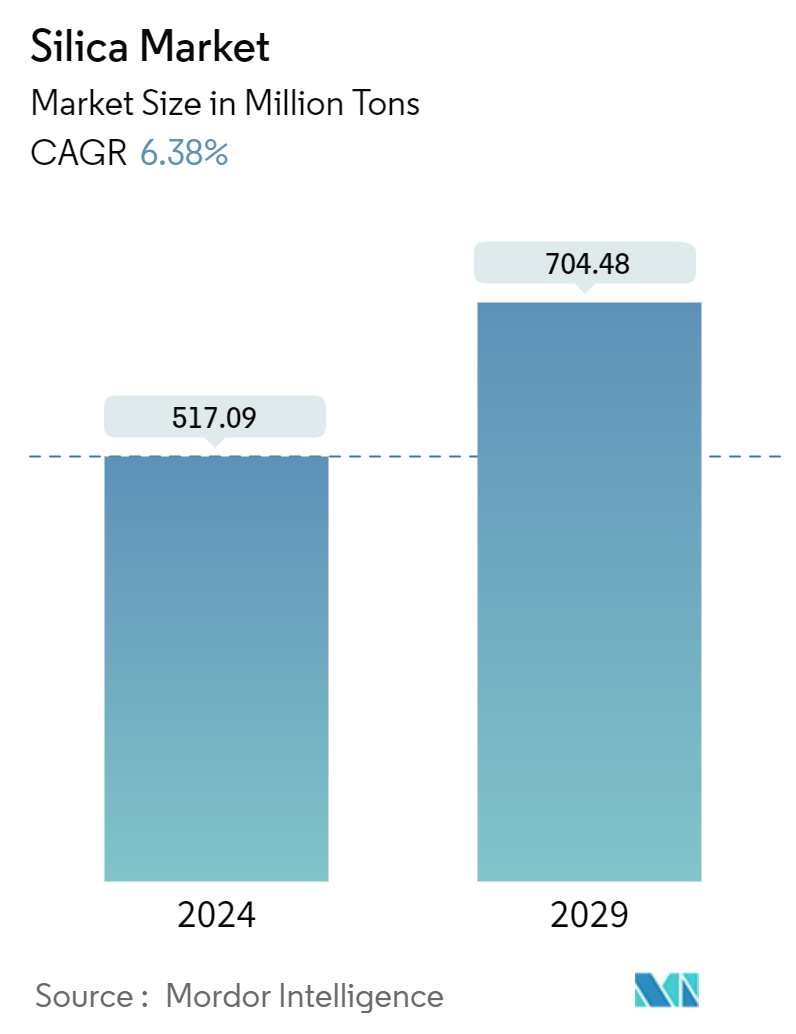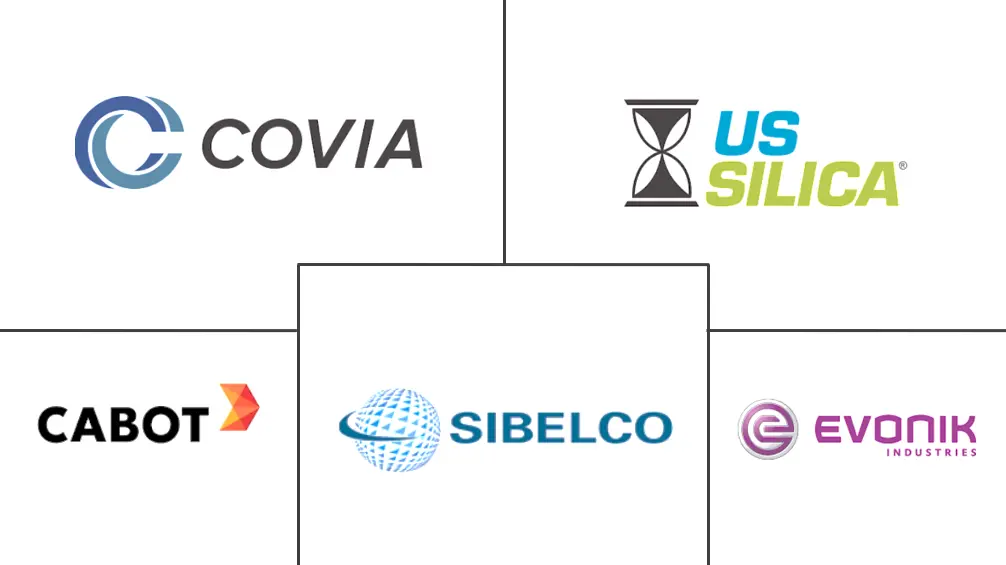Market Size of Silica Industry

| Study Period | 2024 - 2029 |
| Base Year For Estimation | 2023 |
| CAGR (2024 - 2029) | 6.38 % |
| Fastest Growing Market | Asia Pacific |
| Largest Market | Asia Pacific |
| Market Concentration | Low |
Major Players
*Disclaimer: Major Players sorted in no particular order |
Silica Market Analysis
The Silica Market size is estimated at 517.09 Million tons in 2024, and is expected to reach 704.48 Million tons by 2029, growing at a CAGR of 6.38% during the forecast period (2024-2029).
The primary consumer for silica is the construction industry, which was negatively impacted by supply chain disruptions, lockdowns, and other challenges during the COVID-19 pandemic. However, with the restart of a few construction activities after the pandemic, the demand for silica started to gain momentum, leading to a balanced market for silica in the construction industry. Increasing high-quality concrete usage is also expected to drive the market in the upcoming years. The use of silica in electronics is another major factor that is likely to drive the market.
- The rising demand for precipitated silica for different end users and rapidly expanding construction activities are likely to drive the growth of the silica market.
- On the flip side, competition from substitute products is expected to hinder the market’s growth.
- The growing emergence of green tires and the increasing adoption of electric and self-driving cars are expected to unveil new opportunities for the market studied.
- Asia-Pacific is expected to dominate the silica market due to the high demand from China, Japan, and India.
Silica Industry Segmentation
Silica, also known as silicon dioxide, is a compound of two elements in the earth's crust: silicon and oxygen. Currently, silica can be used in a wide range of applications. Silica sand is used in the form of Portland cement, mortar, and concrete, and sandstone is used in the construction of buildings and roads.
The market is segmented by type, end-user industry, and geography. By type, the market is segmented into amorphous and crystalline. By end-user industry, the market is segmented into building and construction, shale oil and gas, glass manufacturing, water treatment, and other end-user industries (paints and coatings, etc.). The report also covers the market sizes and forecasts for the silica market in 27 countries worldwide. For each segment, the market sizing and forecasts have been done based on volume (tons).
| Type | |||||
| |||||
|
| End-user Industry | |
| Building and Construction | |
| Shale Oil and Gas | |
| Glass Manufacturing | |
| Water Treatment | |
| Other End-user Industries |
| Geography | |||||||||||
| |||||||||||
| |||||||||||
| |||||||||||
| |||||||||||
|
Silica Market Size Summary
The silica market is poised for significant growth, driven primarily by the construction and electronics industries. The resurgence of construction activities post-COVID-19 has rekindled demand for silica, particularly in high-quality concrete applications. Silica's role as a key component in various construction materials, such as flooring, mortars, and specialty cement, underscores its importance in enhancing durability and structural integrity. The market is also witnessing increased interest due to the expanding use of precipitated silica across different end-user sectors. However, the market faces challenges from competition with substitute products, which could potentially impede its growth trajectory. Despite these challenges, the emergence of green tires and the rise of electric and self-driving vehicles present new opportunities for market expansion.
The Asia-Pacific region is expected to lead the silica market, fueled by robust demand from China, Japan, and India. These countries are experiencing rapid construction growth, with significant investments in infrastructure projects. China's ambitious construction plans, including substantial investments in key projects, highlight the region's dominance. Similarly, India's focus on affordable housing and Japan's preparations for the World Expo in Osaka further bolster the region's market position. The silica market is characterized by fragmentation, with both international and domestic players such as Covia Holdings, US Silica, Sibelco, Cabot Corporation, and Evonik Industries AG actively participating. Strategic moves, like Heraeus's acquisition of HS Advanced Materials, indicate ongoing efforts to expand product offerings, particularly in the semiconductor industry.
Silica Market Size - Table of Contents
-
1. MARKET DYNAMICS
-
1.1 Drivers
-
1.1.1 Increasing Demand of Precipitated Silica for Different End Uses
-
1.1.2 Rapidly Expanding Construction Activities
-
-
1.2 Restraints
-
1.2.1 Competition from Substitute Products
-
-
1.3 Industry Value Chain Analysis
-
1.4 Porter's Five Forces Analysis
-
1.4.1 Bargaining Power of Suppliers
-
1.4.2 Bargaining Power of Buyers
-
1.4.3 Threat of New Entrants
-
1.4.4 Threat of Substitute Products and Services
-
1.4.5 Degree of Competition
-
-
1.5 Technological Snapshot
-
-
2. MARKET SEGMENTATION (Market Size in Volume)
-
2.1 Type
-
2.1.1 Amorphous
-
2.1.1.1 Pyrogenic/Fumed
-
2.1.1.2 Hydrated
-
-
2.1.2 Crystalline
-
2.1.2.1 Quartz
-
2.1.2.2 Tridymite
-
2.1.2.3 Cristobalite
-
-
-
2.2 End-user Industry
-
2.2.1 Building and Construction
-
2.2.2 Shale Oil and Gas
-
2.2.3 Glass Manufacturing
-
2.2.4 Water Treatment
-
2.2.5 Other End-user Industries
-
-
2.3 Geography
-
2.3.1 Asia-Pacific
-
2.3.1.1 China
-
2.3.1.2 India
-
2.3.1.3 Japan
-
2.3.1.4 South Korea
-
2.3.1.5 Malaysia
-
2.3.1.6 Thailand
-
2.3.1.7 Indonesia
-
2.3.1.8 Vietnam
-
2.3.1.9 Rest of Asia-Pacific
-
-
2.3.2 North America
-
2.3.2.1 United States
-
2.3.2.2 Canada
-
2.3.2.3 Mexico
-
-
2.3.3 Europe
-
2.3.3.1 Germany
-
2.3.3.2 United Kingdom
-
2.3.3.3 Italy
-
2.3.3.4 France
-
2.3.3.5 Russia
-
2.3.3.6 Spain
-
2.3.3.7 NORDIC
-
2.3.3.8 Turkey
-
2.3.3.9 Rest of Europe
-
-
2.3.4 South America
-
2.3.4.1 Brazil
-
2.3.4.2 Argentina
-
2.3.4.3 Rest of South America
-
-
2.3.5 Middle East and Africa
-
2.3.5.1 Saudi Arabia
-
2.3.5.2 South Africa
-
2.3.5.3 Nigeria
-
2.3.5.4 Qatar
-
2.3.5.5 United Arab Emirates
-
2.3.5.6 Egypt
-
2.3.5.7 Rest of Middle East and Africa
-
-
-
Silica Market Size FAQs
How big is the Silica Market?
The Silica Market size is expected to reach 517.09 million tons in 2024 and grow at a CAGR of 6.38% to reach 704.48 million tons by 2029.
What is the current Silica Market size?
In 2024, the Silica Market size is expected to reach 517.09 million tons.

